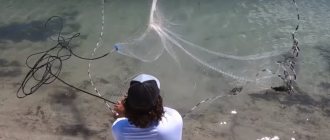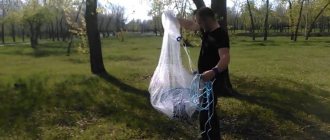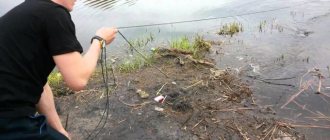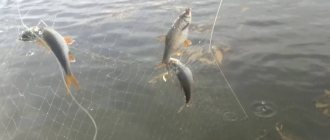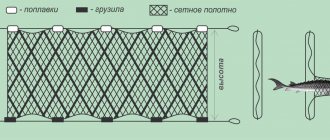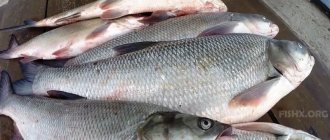- March 28, 2020
- Legislation
- Natalia Kalinichenko
Fishing is a favorite pastime for many men on the planet. Despite the fact that this is no longer a way of survival, many still go fishing.
However, the depletion of water resources forces the government to take extreme measures and impose bans and various types of sanctions on many types of fishing. In particular, there is a fine for fishing with nets.
The last few months of last year were stressful for all anglers. The Duma was considering a bill to introduce new rules and penalties for them. Naturally, everyone is concerned about the question of what the fine is for fishing with nets, what can be used and what cannot be used. What other innovations are planned?
The danger of nets for representatives of aquatic biological resources
Just by touching the net, fish and other animals can instantly become entangled. As a rule, they cannot free themselves from captivity.
It is difficult to imagine the scale of the damage if the network is 15 x 30 meters in size. Such fishing can devastate a small body of water in a few days. This type of fishing is especially dangerous during the spawning season.
I would like to believe that a large fine for fishing with nets is still able to stop fishermen who do not care at all about environmental standards and are not concerned about maintaining the balance in nature.
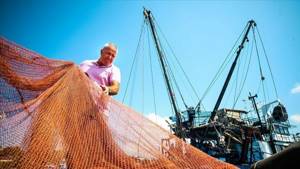
Casting network. Poaching or not?
This type of fishing, such as a casting net, appeared in Russia not so long ago.
Domestic fishermen, in principle, were not familiar with the very concept of a casting net. According to some sources, it turns out that this fishing tool came to us from Asia or America quite recently. However, this is a little different. At least in the southern regions of Russia, similar gear was used back in the last century. And such a net for catching fish was called very simply - cape (emphasis on the first syllable).
Yandex.Direct constantly advertises this fishing gear. Is it possible to fish with a casting net in Russia?
It is not entirely clear what is sporting in this net, but a casting net or cape, or today’s popular name for this net, a parachute, is one of the most effective fishing tools. Effective casting of a parachute net will require the fisherman to perform some acrobatic feats. That, in principle, is the whole difficulty of catching fish with a casting net.
Fishing with a parachute net is very effective
You can fish with a casting net both from the shore and from a swimming device, for example from a Gladiator PVC boat, which can be bought in the Rumpel online store by following the link https://rumpel-land.ru/lodki-naduvnye /gladiator. In addition to boats, the store offers for sale: motors and generators for boats, echo sounders. There are installments and loans.
In current conditions, any fisherman can turn into a poacher. For this it is enough:
- use, without permission from the fisheries protection authority, new tools and methods of fishing that are not provided for by the Rules of the Russian Federation;
- find yourself on a body of water or nearby (!!!) with poisonous or explosive substances, as well as with fishing gear, the use of which is prohibited at a given time and in a given place;
- move on a watercraft in waters and spawning grounds prohibited for fishing during spawning periods;
- export or carry out a catch of fish and crayfish in quantities greater than the daily catch rate per person;
- remove fishing gear belonging to other persons from the water.
These were excerpts from paragraph 3.14. Rules for amateur and sport fishing of the Russian Federation.
With any fishing method, you should not catch more fish than necessary
What the law says
Restrictions may differ slightly depending on the region, but the general rules can be separated into a separate list:
- it is impossible to catch rare species;
- fishing is carried out exclusively in permitted quantities and with weight restrictions;
- The use of certain devices and devices, including networks, is prohibited;
- fishing is prohibited during spawning;
- There are restrictions on the use of watercraft for fishing, in particular on the size, type, and number of vessels.
The responsibility for carrying out control is assigned to Rybnadzor. Only Rosrybolovstvo, which operates at the federal level, has the right to regulate restrictions.
At the level of self-government bodies of the Russian Federation, fishing rules can be regulated, but they must take into account the social, environmental and economic characteristics of the region.
Where fishing is prohibited
A fine for catching sterlet and other types of fish is strictly prohibited, regardless of the region of the Russian Federation, in the following places:
- in farms where spawning takes place;
- in fish farms;
- in any body of water where young individuals are released;
- around fairways, near dams and bridges;
Naturally, under no circumstances should you fish if we are talking about a protected area or a nursery.
You cannot violate the ban on territories belonging to military installations or waters of defensive importance. There is also a ban on places with high security and limited access for citizens of the country.
Confiscation
What else is additionally prescribed without fail? We have already found out how much the fine for fishing with nets (or rather, for fishing in violation of established rules) is. But this is only the first case. And in addition to monetary payments, he will be subject to some other measures to prevent repeated violations.
Namely, the seizure of the vessel on which they were fishing, as well as all the equipment involved in this case. That is, there will be confiscation of everything that could provoke another violation. You can get all this back only after paying a fine.

By the way, it will be applied to each participant in the event. If you did not go fishing alone, then your friend will also suffer the appropriate punishment. Please take this fact into account before breaking the established rules.
Where can you fish
Remember that recreational fishing is legal and free. This applies to the entire country. You can fish everywhere, with the exception of the above places and seasons, when fishing is completely prohibited, that is, during the spawning period.
Fishing is permitted on all public waters. The exceptions are protected areas and private fish farms. If the latter farm does not have a fishing ban, then the fisherman will have to comply with the rules established by this enterprise.

What are the penalties for illegal fishing?
For the illegal extraction of aquatic biological resources, certain penalties are provided that are significant enough to stop the destruction of aquatic life.
According to the law of the Russian Federation, fishing with a net provides for criminal liability or a fine. The amount per fish caught may vary. The quantity depends on relevant factors.
So, if a violator is caught while fishing in a net in a prohibited place, then he will face:
- Collection from 2 to 5 thousand rubles.
- Boat confiscation.
- Removal of nets.
- Payment for all fish caught separately.
If you calculate the total amount for all the above points, then the punishment will be about 500 thousand rubles. However, if the injury did not lead to the death of the fish, then 50% will be recovered for each aquatic animal caught. But for a female with caviar you have to pay double the price. In any case, if the law was ignored, then you will have to pay a lot of money for fishing.
orybalke.com
The total amount and fine for fishing with nets may depend on several factors.
According to Article 8.17 of the Code of Administrative Offenses of the Russian Federation: “Violation of the rules for the extraction (catch) of aquatic biological resources and other rules regulating the implementation of industrial fishing, coastal fishing and other types of fishing in internal sea waters, in the territorial sea, on the continental shelf and in the exclusive economic zone of the Russian Federation , - entails the imposition of an administrative fine on citizens in the amount of one half to one of the value of the aquatic biological resources that were the subject of the administrative offense, with or without confiscation of the vessel and other instruments for committing the administrative offense;
for officials - from one to one and a half times the value of the aquatic biological resources that were the subject of an administrative offense, with or without confiscation of the vessel and other instruments for committing an administrative offense; for legal entities - from two to three times the value of the aquatic biological resources that were the subject of an administrative offense, with or without confiscation of the vessel and other instruments for committing the administrative offense.”
Penalty for fishing with nets . And now, if we say all this much simpler and clearer, we have the following:
If someone is caught (hopefully not you) fishing with nets for spawning or in places prohibited for fishing, then: - you must pay a fine (from 2000 to 5000). Read separately about fines for fishing. - your boat will be confiscated; - your nets will be confiscated (if the fact of fishing with them is proven); -you will also have to pay for each head (i.e. fish) caught.
Based on this, the amount establishing a fine for fishing with nets can reach as much as 500,000 rubles. Therefore, be careful.
If you are an official, the fine for fishing with nets will be even higher.
And remember: a ban on fishing is a ban on fishing! And not a test of ingenuity and intelligence on how to circumvent the current legislation.
Happy fishing. And you will never know what a fine is for fishing with nets.
rybalka7.ru
Catch standards
By law, it is allowed to catch fish in the amount of 5 kg per person per day. There is only one exception: the weight of 1 fish exceeds this figure.
The norm increases by 5 kg for every day if fishing lasts for several days.
There are also standard indicators in pieces for certain types:
- carp;
- pike perch;
- silver carp;
- soma;
- grass carp.
These species can be caught no more than 5 kg during the day. You can catch no more than 30 crayfish. However, you should always remember that each region may have different regulations.
In 2 days from fishing you can take out no more than double the norm established for catching. This takes into account any fish, both live and dried, salted and smoked.
There are no restrictions on the catch of minnows, bleak and ruff.
No more than 30 live bait can be used as bait. This norm is calculated for each fisherman per day.
Prohibited species for fishing
There is a fine for catching fish with nets. In this case, it does not matter at all what type or size of gear. In addition to this, there are several other prohibited methods:
- using traps and snares;
- passive means, especially in salmon habitats;
- using pneumatic weapons;
- you cannot use hooked fishing devices;
- trawls.
Punishment is also provided for fishing with a fishing rod with 10 or more hooks per person. It is unacceptable to kill fish and block their movement.

What is prohibited from fishing?
Mainly prohibited are methods and methods that cripple fish, lead to the catch of young fish, destroy all living things, or prevent aquatic inhabitants from restoring their numbers.
What is prohibited from fishing:
- networks;
- jamming with explosives;
- traps (muzzles, tops, etc.) excluding crayfish;
- installation of dams and other barriers;
- drainage of reservoirs;
- bait with light;
- to the closure;
- electroshock devices and electric fishing rods;
- guns and other firearms;
- scuba gear;
- bagasse traps and harvesters;
- winter fishing with the construction of huts and temporary structures on the ice;
- hunting for crayfish by diving and wading;
- hook traps;
- spears and other devices for impaling from the shore or boat;
- traps;
- bottom trawls;
- TVs and other network-based traps;
- catfishers.
What is allowed to fish:
- girders and mugs - no more than 10 hooks per 1 angler;
- crayfish - no more than 3 pieces per person (the diameter of the crayfish is no higher than 80 cm, and the mesh cells are more than 22 mm);
- trolling on motor or sailing vessels - 2 baits per vessel and no more;
- spans - up to 10 hooks per 1 catcher;
- from watercraft - if they are not officially registered, do not have registration marks, as well as in spawning areas when it is in progress;
- passive gear (slings, hooks, etc.) - on rivers where salmon fish live;
- pneumatic weapons - except those specially designed for spearfishing;
- spinning rods and fishing rods - up to 10 hooks for all for 1 person;
- spinning rods and fishing rods - up to 5 pieces per 1 angler;
- lifts, scoops - with a size of more than 1 meter in width and length and a mesh cell no finer than 10 mm.
When to release the fish
Current legislation prohibits the harvesting of young animals. For each type, there are limiting dimensions, so it is best to have a tape measure with you and immediately take measurements so as not to receive a fine.
The fish is measured from the highest point of the snout to the middle rays of the caudal fin. When it comes to crustaceans, the length is measured from the tail plates to the middle of the eyes.
Minimum sizes of fish when they need to be released:
- 9 cm for cancer;
- 15 cm for herring, trout and poust;
- 16 cm for ramming;
- 20 cm for barbel and chub;
- 30 cm for carp;
- 38 cm for pike perch;
- 40 cm for catfish;
- 50 cm for silver carp.
Depending on the region, sizes may be smaller or larger.
Prohibited networks
There are several types of nets that are strictly prohibited and entail an inevitable fine for fishing with nets during spawning and at other times. Such gear includes:
- “Chinese” or fishing line tackle. It is extremely dangerous for representatives of medium and small water depths. Most often, it is from wounds on the fishing line that fish die.
- Nylon network. This gear poses no less a threat to representatives of water bodies. It is dangerous for medium and large individuals.
- Dragnet. This gear has been known to mankind for many centuries; it is also called a seine or drag. The length of the seine can range from 6 to 200 meters with an average width of 20 meters. Naturally, this method will require several people. Using a seine, the water is actually filtered.
- Floating net. It allows you to practically scrape off all bottom living creatures.
You cannot use a valve, that is, a trap from the network.
What can be considered a fishing net?
In terms of penalties for poaching fishing with nets in Russia, all gear of this type is recognized. Their use will inevitably result in a fine. In addition to nets, the law prohibits fishing with the following devices:
- Airguns;
- traps;
- trawls;
- passive means in salmon habitats;
- self-catching hook devices;
- electric fishing rods, etc.
Even for the wrong fishing rod you can get a fine. These include gear that has more than 10 hooks per angler. Also considered poaching is the use of bagasse traps and harvesters, diving fishing, and huts on ice. It is forbidden to stifle fish, block its movement, illegal fishing or using trolling.
Casting network
This is a relatively new method of fishing, it is also called casting or parachute fishing. It is not classified as a prohibited species, but will require a license and payment of a fee. However, you should be careful: in some regions the technique is still prohibited, so it is recommended to use casting nets at paid rates, and get rid of small fish immediately.
A casting net allows you to fish from a boat and even from the shore, but this requires certain skills.
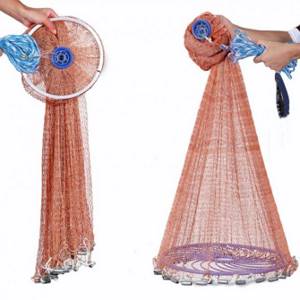
Fishing with a casting net. Basics.
The casting net, or as it is called in Russia, the casting net, is without a doubt one of the most impressive fishing gears. The fisherman makes a swing and a fantastic circle suddenly unfolds in the air from a shapeless skein of ropes and threads, beautifully covering the surface of the water... and within a minute a rich catch falls at the fisherman’s feet. Both aesthetically pleasing and productive! Isn't it an ideal fishing tool?
Having come across videos on fishing with a cap net on the Internet (you will find links to watch and download them in the notes to this article), you will probably think that this is the happiness of a fisherman. One throw - a bucket of fish. But the realities are such that, as a rule, everything will not be so smooth and, as they say: the “net” will often come not with fish, but with “grass of the sea”... But we will strive for perfection and in this series of articles there will be just and it is described what and how to do so as to never leave the reservoir without rich spoils.
Legal aspects of net fishing.
For those who believe that casting net fishing, or as it is called all over the world, is poaching (and in most CIS regions, by law, it is so), I will immediately say that we will not discuss this here (although your opinions are in the comments will be useful). I will only say that in many regions such fishing is allowed, but is limited to a net size of up to 2 meters, similar to the one for the little fish. In addition, if you treat casting net fishing as a sport, and elite sports, as you know, are not cheap hobbies, then we can assume that for the sake of your hobby you are ready to pay the local fish inspectorate for a license for net fishing, so Moreover, you don’t need a large fishing quota. Reasoning on this matter can be read here and here, but let’s return specifically to fishing with a cassette net as a subject.
Types of casting networks. Theory.
Having decided to engage in this type of fishing, you will need to decide for yourself which type of casting nets will be more convenient for your soul to use. The most common types are Spanish and American.
The American casting network is a dome, the bottom of which is planted with a loaded cord, from which, along the entire perimeter from the inside to the top of the cone, ropes tied at certain distances go up, they are called slings. At the top of the cone, the slings are brought together into a single hole (ring), in such a way that when the net is pulled up behind them, the slings wrap its lower edge inward, forming a kind of bag around its entire circumference.
For example, this net manufactured by the Japanese company Momoi Fishing is shown in Figure 1.
Fig.1
- network fabric;
- cargo;
- ring and carabiner;
- throw cord.
The Spanish casting net forms the same bags (in it they are called pockets), but not with the help of the edges of the net drawn inward with slings, as in the “American” one, but has them right by design. Pockets are initially tied during manufacturing and attached with special threads to the main mesh fabric along the entire perimeter (see Fig. 2).
Fig.2.
- Network fabric;
- Loaded cord;
- A throw cord tied to the top of the net cone with a hand loop.
There are also African and other types of nets, which are essentially the same 2 main types listed above, but slightly modified to suit fishing conditions. It is worth noting that on the Internet and among fishermen this net can be heard by different names - it’s a parachute, a cape, a seine, a castnet and a cast net (from the English Cast Netting) and simply a cast net or a cast net - all this is about fishing with a casting net .
As already mentioned, in order to start using a casting net you need to learn how to cast it, and this, despite all its apparent simplicity, is actually not so simple.
The Japanese consider casting the net an art. In this country, the act of laying a net and throwing it has been elevated to the rank of a ritual. Such competitions in Japan are called Oka-ami, and the Tosa-ryu casting net technique is considered no less prestigious than the technique of wielding the Japanese sword - the katana.
How to get a license
In order not to wonder what the fine for fishing with nets is, it is better to contact the regional office of Rosrybolovstvo and clarify all the details. If there is no prohibition in a particular area, then you can obtain a personal permit or license. True, you will have to pay both for the license itself and for fishing a certain species.
The document must indicate not only the full name of the permit holder, but also the fishing location, the amount of possible catch, including the total weight, and the validity period. An additional payment is allowed for catching especially valuable species of fish. For example, in Siberia it is allowed to catch salmon, but you will have to pay 300 rubles for each individual, and 35 rubles for pink salmon.
A permit obtained in the Far North is valid throughout Russia, but does not give the right to catch valuable species of fish. It is very important to know that fish caught under such a permit cannot be sold, but can be used exclusively to meet one’s own needs.
Such documents can also be obtained from private farms that own fisheries and provide fishing services. By the way, in such farms you can engage in industrial fishing, that is, not to satisfy your own needs or for the sake of interest, but for sale.
It should also be remembered that the law provides for a fine for catching sterlet and other rare species of fish. The permit is issued personal, that is, it is not transferable to third parties, so it is in the interests of the fisherman himself not to take risks.

Fishing with nets will be allowed, but only after their registration and only in certain places
The Verkhneobsky territorial department of the Federal Fisheries Agency reports that in accordance with changes in legislation, starting from 2021, amateur fishing using net fishing gear will be allowed. But only after their registration and only in specially designated fishing areas.
Below you will find information on the procedure for registering networks, approved by the Decree of the Government of the Russian Federation. Regarding the parameters of the nets subject to registration, as well as the places of permitted fishing, regulatory documents are being developed. For all questions, advice can be obtained from the Verkhneobsky territorial department of the Federal Fisheries Agency or from any of its structural divisions.
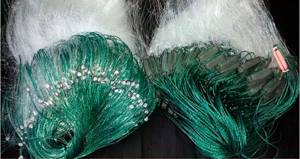
The Verkhneobskoye TU of the Federal Fisheries Agency (Altai Republic, Altai Territory, Kemerovo, Novosibirsk, Omsk, Tomsk regions) informs about the following.
“Until 2021, issues of recreational fishing in the territory controlled by the Verkhneobsky TU of Rosrybolovstvo were regulated by Federal Law dated December 20, 2004 No. 166-FZ “On Fisheries and Conservation of Aquatic Biological Resources” and the Fishery Rules for the West Siberian Fishery Basin, approved by order of the Ministry of Agriculture of Russia dated 10.22.2014 No. 402, also in some cases by the Water Code of the Russian Federation and Federal Law of 04.24.1995 No. 52-FZ “On the Animal World”.
The above regulatory legal acts are also valid in 2020.
At the same time, on January 1, 2021, the Federal Law of December 25, 2018 No. 475-FZ “On recreational fishing and on amendments to certain legislative acts of the Russian Federation” came into force, as well as several of its by-laws, including the resolution of the Government of the Russian Federation Federation dated November 21, 2019 No. 1482 “On approval of the rules for recording net gear for the extraction (catch) of aquatic biological resources and maintaining a register of net gear for the extraction (catch) of aquatic biological resources and the rules for mandatory piece marking of net gear for the extraction (catch) of aquatic biological resources” (hereinafter - Rules).
In accordance with the requirements of the Rules, net fishing gear used for recreational fishing is subject to mandatory registration with fisheries protection authorities and labeling.
At the same time, we inform you that in order to register a net fishing gear and obtain a marking number, you must submit an application to the territorial departments of the Verkhneobsky territorial administration of the Federal Fishery Agency to enter information into the register.
The application is submitted to the territorial body or to the multifunctional center for the provision of state and municipal services in person, or by mail, or electronically
The application must indicate:
a) the name of the territorial body to which the application for entering information into the register is submitted;
b) last name, first name, patronymic (if any) of the owner of the net tool (for individuals and individual entrepreneurs) or the full name of the legal entity that is the owner of the net tool (for a legal entity);
b) date and place of birth of the owner of the net tool (for individuals);
d) address of the place of residence (place of stay) of the owner of the net tool (for individuals);
e) address of the location of a legal entity or individual entrepreneur;
f) individual taxpayer number of the owner of the net tool (for individuals, if available);
g) mandatory state registration number (for legal entities);
h) the main state registration number of the record of state registration of an individual entrepreneur (for individual entrepreneurs);
i) contact telephone number and (or) email address (if available) of the owner of the net tool;
j) details of the identity document of the owner of the net tool (for individuals);
k) the name of the net tool, information about which is subject to entry into the register, indicating:
- for gill nets - length, height, mesh size (step);
- for seines of all types, drags - length, height, mesh size (step);
- for net traps of any type, other net fishing gear - information about the main design characteristics in equipped (extended) form (length, height, width, mesh size (pitch), including the characteristics provided for net traps by fishing rules;
l) water bodies where the owner of a netting tool plans to carry out recreational fishing using netting gear (indicating the constituent entity of the Russian Federation, municipalities (districts) of the constituent entities of the Russian Federation and the location relative to the populated areas on whose territories such water bodies are located or adjoining objects);
Within the responsibility of the Verkhneobsky TU of the Federal Fishery Agency, the areas permitted for the circulation and use of gill nets are understood as land territory and inland waters: the Altai Republic, Altai Territory, Novosibirsk, Omsk, Tomsk regions (clause 2 of the Regulations approved by Government Resolution No. dated 16.11.2019 1462).
m) details of the current agreement for the use of a fishing area provided for the organization of recreational fishing (number, date of conclusion of the agreement) (for legal entities and individual entrepreneurs);
o) information that the owner of the netting gear is familiar with the requirements of the fishing rules for the fishery basin on the territory of which it is planned to carry out recreational fishing using netting gear.
After receiving a positive response with the number, you must independently make and attach a sign to the network indicating:
a) last name, first name and patronymic (if any) of the owner of the net tool (for individuals and individual entrepreneurs) or the full name of the legal entity that is the owner of the net tool (for a legal entity);
b) characteristics of the netting tool, including: for gill nets, seines of all types, dragnets - length, height, size (pitch) of the mesh; for net traps of any type and other net fishing gear - information about the main design characteristics in equipped (extended) form (length, height, width, mesh size (pitch), including the characteristics provided for net traps by fishing rules;
c) the registration number of the net weapon.
Information on markings must be legible and accessible for visual inspection without the use of aids.
In the event of a change in the place of residence (if registered) or place of stay (if registered) of the owner of a net tool, re-equipment (modernization) of a net tool, the owner of a net tool is obliged to provide relevant information about changes to his registration data by sending an application for changes to his registration data to the territorial authority within 15 working days from the date of occurrence of one of the specified events.
In the event of a change in the owner of a net weapon, loss (loss) of a net weapon, as well as in the event of disposal or destruction of a net weapon without replacing the net weapon with an equivalent one in parameters, the previous owner of the net weapon is obliged to provide the appropriate information about the cancellation of the registration number in the register by sending an application for cancellation of the account number in the register to the territorial body within 15 working days from the date of occurrence of one of the specified events.
An application for changes to the registration data and an application for cancellation of the registration number in the register are submitted personally by the owner of the net tool that has the registration number, to the territorial body or to the multifunctional center for the provision of state and municipal services, or in electronic form using information and telecommunication technologies, including including a single portal and (or) regional portals.
The application for changes to credentials shall include the following information:
a) the name of the territorial body to which the application for changes to the registration data is submitted;
b) last name, first name, patronymic (if any) of the owner of the net tool (for individuals and individual entrepreneurs) or the full name of the legal entity that is the owner of the net tool (for a legal entity);
c) the registration number of the net tool for which data changes are required;
d) address of the place of residence (place of stay) or location of the owner of the net tool;
e) contact telephone number and (or) email address (if available) of the owner of the net tool;
f) data to be replaced;
g) new data to be included in the register.
The application for cancellation of an account number in the register shall indicate:
a) the name of the territorial body to which the application for cancellation of the account number in the register is submitted;
b) last name, first name, patronymic (if any) of the owner of the net tool (for individuals and individual entrepreneurs) or the full name of the legal entity that is the owner of the net tool (for a legal entity);
c) the registration number of the net tool, the registration of which is cancelled;
d) address of the place of residence (place of stay) of the owner of the net tool;
e) contact telephone number and (or) email address (if available) of the owner of the net tool;
f) reasons for canceling the account number.
The account number is canceled based on:
a) applications for cancellation of the account number in the register;
b) a court decision on the confiscation of a net weapon.
In case of disposal or destruction of a net tool due to significant wear and tear of the net tool (loss of its properties under the influence of natural factors), the owner of the net tool has the right to replace the net tool with an equivalent one according to the parameters that were originally entered into the register, and to use it without submitting an application for making changes to his credentials or applications for cancellation of the account number in the register to the territorial body. At the same time, a net tool that has lost its properties cannot be used for recreational fishing.”
Addresses and telephone numbers of the Verkhneobsky territorial administration of the Federal Fisheries Agency and its divisions:
| Subdivision | Address | Telephone |
| Manadgement Department | 630091, Novosibirsk region, Novosibirsk, st. Pisareva, 1. | (383) 221-26-93; |
| Altai Department of State Control, Supervision and Protection of Aquatic Bioresources and Their Habitats | 656002, Altai Territory, Barnaul, st. Molodezhnaya, 2a | (3852) 667-404 |
| Gorno-Altai Department of State Control, Supervision and Protection of Aquatic Bioresources and Their Habitats | 649000, Altai Republic, Gorno-Altaisk, st. Choros-Gurkina, 37 | (384) 231-7307; (384) 231-2767; (388) 222-3559; (384) 231-7307; (384) 231-2767; (388) 222-3559 |
| Kolpashevo Department of State Control, Supervision and Protection of Aquatic Bioresources and Their Habitats | 636460, Tomsk region, Kolpashevo, st. Kirova, 36 | (38254) 504-07 |
| Tomsk Department of State Control, Supervision and Protection of Aquatic Bioresources and Their Habitats | 634040, Tomsk region, Tomsk, st. Vladimir Vysotsky, 25, building 4 | (382) 246-12-77; |
| Kemerovo Department of State Control, Supervision and Protection of Aquatic Bioresources and Their Habitats | 650070, Kemerovo region, Kemerovo, st. Tukhachevsky, 29a | (384) 231-7307; (384) 231-2767; (384) 231-7307; (384) 231-2767 |
| Omsk Department of State Control, Supervision and Protection of Aquatic Bioresources and Their Habitats | 644046, Omsk region, Omsk, st. Stepnaya, 220 | (381) 237-3114; (381) 237-3114 |
| Orda Department of State Control, Supervision and Protection of Aquatic Bioresources and Their Habitats | 633261, Novosibirsk region, r.p. Ordynskoye, st. Sadovaya, 27a | (383) 59-24-240 |
| Novosibirsk Department of State Control, Supervision and Protection of Aquatic Bioresources and Their Habitats | 630098, Novosibirsk region, Novosibirsk, st. Gidromontazhnaya, 48 | (383) 326-0201 |
| Baraba Department of State Control, Supervision and Protection of Aquatic Bioresources and Their Habitats | 632331, Novosibirsk region, Barabinsk, st. Lenina, 58 | (38361) 21-407 |
Sanctions for networks
For many who like to feast on representatives of aquatic resources, the answer to the question of what fine is imposed for fishing with nets is important. There are quite severe sanctions for such a violation.
First of all, Art. 8.37 of the Administrative Code provides for a fine of 2 to 5 thousand rubles. The nets will be confiscated without fail, and if the fishing was still carried out on a boat, then it will be confiscated.
For officials, the sanctions are even harsher. A fine of 20 to 30 thousand rubles may be imposed on the head of the enterprise. The vessel, nets and other prohibited fishing equipment are also subject to confiscation. A legal entity will be subject to a fine of 100,000 to 200,000 rubles.
And if the fishing was carried out using prohibited gear and, moreover, without permission, then you will have to pay from 3,000 to 5,000 rubles. Increased rates are provided for officials: 5-10 thousand rubles, and even higher fines are provided for legal entities: 10 times higher than for enterprise managers. These sanctions are provided for in Art. 7.11 Code of Administrative Offences.
The fine for fishing with nets during the spawning period and in the presence of other prohibitions for certain representatives of the deep waters is:
- for smelt, capelin and saury you will have to pay from 55 rubles per 1 individual;
- for crabs 680 rubles;
- for mullet and halibut from 675 rubles;
- catfish, carp, pike, grass carp and carp will cost 975 rubles;
- for chum salmon 2,000 rubles;
- for flounder and pike perch from 3,300 to 3,500 rubles;
- sterlet will cost even more: from 4,500 rubles;
- for salmon and sockeye salmon from 11,500 to 13,600 rubles.
And the most expensive from the list are kaluga and beluga. For these types of fish you will have to pay from 206 to 269 thousand rubles, although the chances of catching such rare species are very small.
It should also be remembered that industrial fishing under the guise of amateur fishing entails criminal liability under Art. 256 of the Criminal Code.
Part 1 of Art. 258 of the Criminal Code also provides for criminal liability for catching protected fish species that are listed in the Red Book. The minimum punishment is 480 hours of community service. The most severe sanction is up to 3 years in prison, with a parallel penalty of 1,000,000 rubles in the form of a fine. However, if such an individual was caught completely by accident and even died, then you will have to answer according to the rules of administrative legislation.
Is it poaching to fish with a casting net? And about poaching honestly...
Legalization of fishing with nets for private individuals.
Article-reasoning.
What prompted me to write this article is that sometimes when visiting various fishing forums I come across the fact that part of their audience with splashes at the mouth is trying to “attack me”, saying “poacher”, “grabber”, “immoral type”, “destroyer of everything” alive”, “away from the reservoir...”, “barbarian”, etc.
I think completely differently. Why? I'll tell you...
What is meant by the word poacher ?
According to dictionaries and Wikipedia, this is someone who engages in poaching, that is, hunts or fishes in prohibited places, at prohibited times or in a prohibited way, and also carries out illegal deforestation, berry picking, etc. That is, about nets here, if not to consider them prohibited only for private individuals in some departmental orders. Create a legal entity, follow the rules and catch. So why does the network mean marriage (evil and merciless).
As for “ grabbing ”...
When fishing, for example, with a casting net, I catch so much that I could cook fish for the table and always have something like half a bucket to dry.
Having caught my norm of 3-5 kg. I usually finish fishing. And so I open the spinning forum and see dozens of pikes at the feet of the happy “sports angler” - the question arises, why do you need them, what is your catch quota? I just want to call it exactly – marriage! And the so-called sports fishing tournaments - look at their scoring results! Tens of kilograms for each of sometimes hundreds of participants (multiply) - this is genocide .
What I mean is that everything can be exaggerated. It doesn’t matter whether a fisherman fishes with a net or with a spinning rod, what matters is the culture of the fisherman himself. the arguments “ nets ruin fish ” to be unfounded and, taking into account private owners’ compliance with fishing rules established for legal entities (observance of fishing deadlines, time the nets remain in the water, size of the yak, etc.), there is no damage from nets used by amateurs to fish will. After all, legal entities and entrepreneurs fish with nets in much larger volumes. And the experience of other countries and, by the way, regions of Russia such as Karelia, shows that legal fishing by private nets does not cause any damage, especially if the money received from the sale of licenses is used to stock water bodies with fish.
Other fines
But you should not think that the severity of the law concerns only the imposition of fines for fishing with nets. Additionally, the catch will be considered. This applies to the size, weight and breed of fish.
In particular, the adopted new fishing rules, which came into force this year, provide for increased rates for a number of violations.
The fine for catching fish with nets during spawning ranges from 100,000 to 300,000 rubles. Instead of payment, the unlucky fisherman may be arrested for 6 months. If there is a female with caviar in the nets, you will have to pay double the cost, but if the fish is alive, then only half of the fine imposed will have to be paid. It is unlikely that such amounts will seem exorbitant for most fishing enthusiasts.
Also during the spawning period the following penalties apply:
- for the destruction of prohibition signs, a fine of 300 to 500 rubles is provided;
- for fishing of prohibited species - from 1,000 to 2,000 rubles with mandatory confiscation of the entire catch, naturally, and the nets themselves;
- for using improper swimming equipment, along with deprivation of rights for a whole year, you will have to pay from 500 to 1,000 rubles.
It should also be remembered that there is not only a fine for catching taimen and other valuable species of fish, but also for improper parking near a reservoir and improper water use. Fines in these cases start from 1,500 and can reach 4,000 rubles.
Analyzing the current legislation regarding the question of how much the fine for fishing with nets is, it immediately becomes clear that it is better to first study the local rules and restrictions. Otherwise, you can “shed” a lot and completely ruin your vacation.
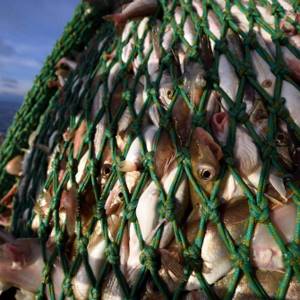
LEGAL ASPECTS OF FISHING WITH LIFTERS, TRAPS, CASTING NETS
LEGAL ASPECTS OF FISHING WITH LIFTERS, TRAPS, CASTING NETS
As has been mentioned more than once, there are no uniform rules regulating what is possible and what is not allowed in amateur fishing in Russia. They differ in different regions, and gear that is permitted in some places is strictly prohibited in others.
It has been noted that the richer the region is in valuable fish species (sturgeon, salmon, whitefish), the more severe the rules, and vice versa. In densely populated areas, where water bodies experience heavy fishing pressure, fishing with net gear is also often very limited.
Here, for example, is how the Fishing Rules in the Northern Fishery Basin (Republics of Komi and Karelia, Arkhangelsk, Vologda, Kirov and Murmansk Regions, Nenets Autonomous Okrug) relate to fishing with traps and catching gear. I take these rules as an example, because they were approved by order of the Ministry of Agriculture of the Russian Federation relatively recently, in April 2007, and reflect the current state of affairs. It should be taken into account that the region is very rich in salmon and whitefish, and therefore the people who wrote the rules did not suffer from excessive liberalism.
So: in the European north of Russia you can fish without permits and licenses (I omit nets, fixed nets, seines, nonsense and traps for crayfish and crabs):
manual lifts and “spiders” with a diameter of up to 2 m;
vents and hemlines with a length of the entire device of no more than 3 m, a trap diameter of no more than 1 m, in an amount of no more than 3 pieces per citizen;
a wick with an opener less than 2 m long, no more than one piece per citizen;
a “baby net” measuring no more than 1.5 x 1.0 m for catching live bait.
Not a lot... But if you purchase a license or obtain permission from the regional fisheries inspection, fishing opportunities expand. Licensed recreational fishermen can additionally use:
fences having a wing(s) length of no more than 10 m;
vents (tops) with a wall length of no more than 10 m, a catching device no more than 5 m and a diameter of no more than 1 m, in the amount of no more than 2 traps per citizen;
traps for ice fishing for lamprey and burbot.
It is curious that sacks and bastings are not mentioned at all in the rules of the northern basin, neither among the permitted gear, nor among the prohibited. However, any omission in the rules is interpreted in favor of the fish inspector - all gear that is not mentioned as permitted is prohibited. But in other regions, officials of the Ministry of Agriculture did not forget about these gears. For example, in the Leningrad region, back in 1989, the rules adopted (however, they are still in force!) allow fishing with bastings on a limited number of reservoirs, as well as with nets with a diameter of up to 1 m, without licenses and permits.
In some places, older by-laws are also applied - for example, a resolution of the Council of Ministers of the RSFSR, dating back to 1958 and prohibiting the sale of net fishing gear in those regions where fishing with them is not permitted by the rules.
The Kaluga region is especially famous in this regard: local courts actively use the mentioned resolution, prosecuting traders who risk selling a chain or a chain. Arguments that in 1958 there were no bodies of water that were privately owned do not work: even if you set up a pond yourself and raised fish in it, but don’t even dream of buying a top or a fish, fish with a fishing rod, since no one has been honored to abolish the outdated resolution. And it is difficult for Kaluga fishermen to go fishing from the Kaluga region to Karelia or another region where fishing with nets is not prohibited...
The newspaper "Rybak Rybaka", famous for its irreconcilable attitude towards the networks, advocates for disseminating the experience of Kaluga residents in using the 1958 decree throughout the country. The pages of the mentioned newspaper covered, for example, the story of the Kaluga private entrepreneur Vinogradova, who had the misfortune of selling two tops, a “screen” and a “kerchief” for a total of 636 rubles and, as a result, earned 14 st. Administrative Code (illegal sale). Moreover, restless newspaper figures published a sample statement addressed to the police and calling for the application of the notorious resolution half a century ago. They say, gentlemen, readers, as soon as you see a network for sale, immediately signal where it should be. We can only hope that not all fishermen reading the newspaper dream of the laurels of Pavlik Morozov and other famous informers.
Features of the application of penalties
The size of the fines is clear, but what is the punishment for fishing with nets, and are there exceptions to the rules?
The easiest way out of a situation where there is no way to pay a fine is a 6-month arrest.
There is another way: simply not pay the fine. 10 days are allotted for this. After 5 months, the documents will be handed over to the bailiffs, but if the amount turns out to be less than 10,000 rubles, it is unlikely that any representative of the judicial system will want to deal with this matter. And if you hold out for 2 years, the statute of limitations will expire and the fine will be automatically paid off.
It should also be remembered that even in regions where the use of networks is allowed subject to obtaining permission, the absence of such a document entails punishment.
In some cases, the sanction may be confiscation of property, and the exact amount of the fine is always determined depending on several factors. In some cases, the fine may even be exceeded.
It should also be remembered that if the fisherman acted within the law and did not violate any rules and regulations, then a representative of the Fishing Supervision Authority has no right to take away the catch.
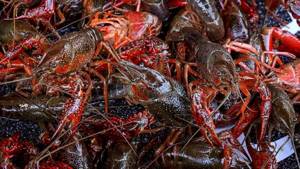
Everything is prohibited
So, before going for fish, every citizen must necessarily learn certain rules for this process. Otherwise, you have the right to be punished by law. Moreover, the fine for fishing (with nets or simply in violation of established standards) can reach enormous amounts. And it’s not always possible to “get off” with cash payments.
Therefore, know that the Law “On Fisheries” of the Russian Federation will be useful to you. Here you can understand all the rules of fishing. And once these rules are observed, you can go “hunting” for fish without any problems. Remember - it is prohibited to use the network at all. And during spawning you also have no right to fish. And in no way. These are the rules. Don't follow them? Prepare to be punished.
Some tips for anglers
Considering how much the fine for netting is and how severe the punishment can be, many hobbyists give up their hobby completely. Completely in vain. Naturally, you should not use nets and other prohibited fishing methods, and it is best to have some things with you that will allow you to avoid sanctions for other violations:
- Scales. It is recommended to always have scales with you when fishing. They will allow you to control the total weight of the catch and the individual fish. Remember that the daily norm is 5 kg.
- Roulette. It is advisable to have a tape measure in the form of a bracelet; it is a compact option that does not take up much space in your bag or car. A tape measure will allow you to instantly get rid of small specimens by releasing them into a pond.
- Screwdriver. It is not required for the most legal action. If fishing is carried out in a water protection zone, then you can rent license plates on your car. Naturally, there is a big risk that you will come across a very persistent inspector who will want to call a tow truck. However, this is a chance to avoid a fine, although we recommend not breaking the law.
Despite this, you should always remember that even if the standards are violated, it is useless to go to court. It will be extremely difficult, one might even say impossible, to prove his innocence.
Before you go fishing, remember that fines for using nets and violating other rules are very high. Therefore, it is best to first familiarize yourself with the local rules and refuse fishing during the spawning period.
About boats and cars
Readers ask, is it possible to fish from a boat? Can I use a motorboat or only oars?
Vitaly Molokov: Here you need to turn to specific fishing rules in the regions. In some places, fishing from the shore with a fishing rod with two hooks is allowed even during the spawning period, but fishing from a boat during the spawning period is prohibited. And somewhere it is stipulated that even the movement of water transport during the spawning period for fishing purposes is limited. If a fishery inspector sees a citizen during the spawning period who is simply walking along the river in a boat, he will also have a fishing rod in his boat, and this results in a movement for fishing purposes. Will be brought to administrative responsibility.
When the prohibited periods end, you can fish with permitted fishing gear both from a boat and from the shore, as you wish. Whether the boat has a motor or not is not important.
By the way, are there different periods for permitted fishing in each region?
Vitaly Molokov: Yes, they are spelled out in the Fishing Rules. For example, for Moscow, the Moscow region and other regions that are part of the Moscow-Oka territorial administration, there is a ban on fishing during the spawning period until June 10. Of course, it happens that weather conditions change, winter can be long or short. So this norm requires changes. Previously, territorial administration could, based on the situation in the region, regulate the timing of the ban. Let’s say the restrictions could have been lifted at the beginning of June, or later based on monitoring data. Now we are planning to return to it. That is, regulate the timing of the ban taking into account the objective situation on the reservoir.
Often fishermen come by car directly to the shore of the lake, pitch tents, and fish. Is this allowed by the rules?
Vitaly Molokov: Here the situation is somewhat twofold. If we take the legal norm, then the movement and parking of vehicles is prohibited in the water protection zone. The water protection zone is set from 50 to 200 meters depending on the reservoir. Let's say, if this is an object of federal significance: a river - the Yenisei, Angara, Ob, Volga, then the water protection zone there will be 200 meters, and if it is a small reservoir or river - 50 meters. That is, you can use draconian methods to drive everyone out of the coastal strip. But there is neither the strength nor the funds for this, and why anger people? If people stop on the shore for tourism and recreation, this does not entail pollution of the reservoir, soil degradation, for example, people do not wash their cars, there is no point in restricting them.
In addition, nothing prevents you from placing two boards on the ground and running over them. Then the car will no longer stand on open ground. This is exactly what the Water Code directly requires. For example, when an industrial enterprise carries out seine fishing, on the shore at the place where the car is planned to be parked, they first lay out a film, then a wooden flooring and calmly stand up. Such measures are justified, since some equipment is old and automobile oils and petroleum products can get into the soil.
Do these rules apply to all bodies of water?
Vitaly Molokov: For everyone. Almost every water body has a water protection zone.

